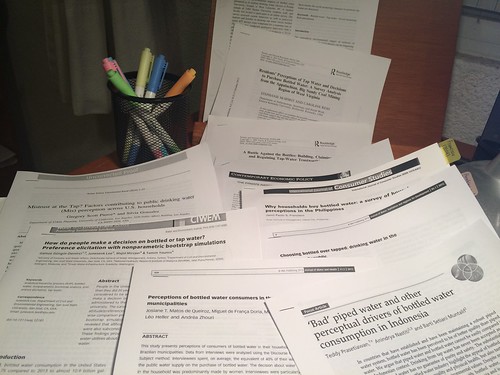As anybody who reads my blog knows, I think a lot about the mechanics of research and especially I have written a lot about how to conduct a literature review. This week, because I have been very ill, I have had a chance to think deeply, and I believe that I have finally found the missing piece linking reading (a lot) with the construction of a literature review.
Many students tell me they don’t know how to organize their literature review, how to start it. That is, I believe, because they don’t know what to look for.
So, what is someone doing a literature review looking for?
1) what has been done (the lay of the land)
- Who has written about my topic?
- What are the results of their work?
- How have they tackled problems that might be similar to mine?
2) the foundations upon which their own work can be developed
- Who are the core authors in this space?
- Which works seem foundational enough to build my own work upon?
- Where have these works been developed? (this opens up new possibilities for geographical spaces and case studies)
3) any possible spaces where they can insert their own contributions,
- Where can my work contribute?
- How would my work dialogue with others’ research?
- If there is a gap, how does my work contribute to narrowing?
- If there is something new to develop, whose work do I extend?
4) a map of themes showing connections
- A mind map of different themes and their connections can help scholars develop their own literature review.
So, in practice, you DO need to read a lot so you can figure out which topics have been discussed in which areas of study, which case studies have been already analyzed, etc.
This first step, I would break it into two stages (depending on the level of understanding of the particular topic under study):
- Make a list of possible topics and issues
This list of topics can’t come out of thin air. Therefore the second stage is:
- Draw guidance from either experts or published reviews to map the list of possible topics.
Normally it is at this stage that I give my students advice on authors and specific citations.
What happens if you don’t have an expert to guide you?
Well, it is very likely that someone already did a literature review about your topic or adjacent to it. We search for the general topic (“a review of topic X”) and it’s likely we will find something that will help us.
For example say I’m doing a project on the dynamics of protests against renewable energy mega projects, specifically windmills. There’s certainly literature on protests. There’s work on extractive industries and their negative impacts, etc.
I could search for literature on these topics. But then the second question my students ask comes up.
“How do you now assemble the literature review into a coherent document?”
There are many ways to do this assemblage, but I believe the Funnel Method is easiest, particularly for anybody who is relatively new to literature reviews.
So what’s the Funnel Method?
It’s basically taking your research through a conceptual funnel (from the most general to the most specific).
In my case, I would follow a structure like this:
1. Conflicts
2. Environmental conflicts
3. Protests against mega projects
4. Protests against windmills
5. Case studies of protests against windmills across the world.
By the time I get to (5) in this list, I would feel pretty confident that I will have at least a broad landscape of the literature. It takes a while to get to the eureka moment. That’s why this exercise is hard.
When you read accounts from doctoral students and seasoned professors regarding when they actually figured out the topic of their thesis and many of them say “oh years after I finished my PhD”, that’s totally believable.
It was so hard for me to find the niche for my PhD thesis!
What I have found, having survived writing 3 theses, supervised many, and taught numerous academic writing courses and PhD workshops across the world is that the more literature reviews I conduct, the easier it becomes for me. Practice makes perfect.
OBVIOUSLY there’s a catch.
The catch is: the literature review (particularly regarding topic selection and assemblage) is driven by the Research Question. A LR doesn’t happen in a vacuum — you need to have a guiding objective – what are you trying to understand or learn. HOWEVER, the LR can ALSO help you develop a solid RQ.
That’s why it’s important to remind learners that the research process is very iterative. It’s not linear and you may need to restart the search from scratch more than once.
Don’t despair!





Keep it up!
I keep coming back to this post of yours. It has been very helpful , thank you very much!